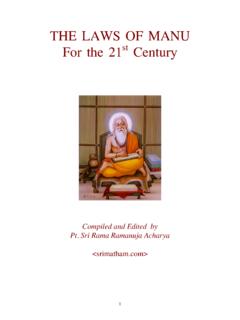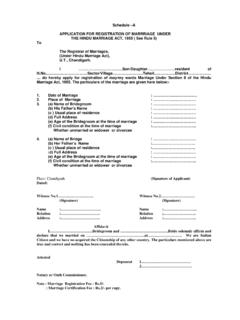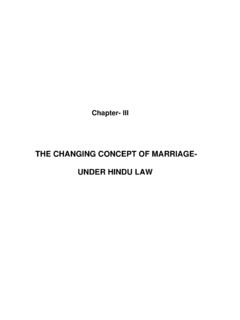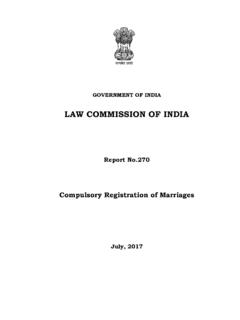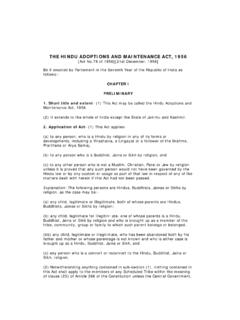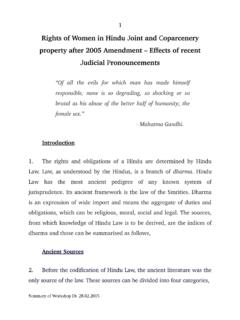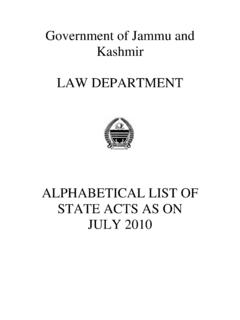Transcription of TTHHEE HHIINNDDUU SSAACCRRAAMMEENNTT …
1 THE HINDU SACRAMENT. OF MARRIAGE. By Pandit Sri Rama Ramanuja Achari Simha publications 2 CONTENTS. Introduction 4. The purpose of Marriage 5. Importance of children 5. Types of Marriage 6. Arranged Marriages & Compatibility 7. Choosing a Partner 8. Guardianship in marriage 9. Betrothal Engagement 10. Dowry 10. Prohibited Relationships 12. The Arrangement of Gotra 12. Choosing a Date for your Wedding 13. Tokens of Marriage Ma gal-s tra & Wedding rings 13. Marriage Ceremonies 15. Finality of Marriage 21. Menstruation During the Wedding 21. Peculiar ceremonies relating to marriage 22. Parivedana 22. The Vedic Marriage Ceremony introduction 24. THE VEDIC SACRAMENT OF MARRIAGE 25. South Indian Version 25.
2 North Indian Version 41. Examples of variant wedding ceremonies South Indian Non-Brahmin wedding 55. V ra Saiva Wedding 58. Post Nuptial Rites 60. Some Significant Symbols 63. Canon Laws of Marriage from the Dharma stras 65. Giving away of the Bride 65. Annulment & Divorce: 65. Rape 67. Adultery 67. Abandoning A Wife 68. Polygamy and Polyandry 68. Same-sex Marriage 69. Duties of Husband and Wife 72. Pa ca Mah Yaj as The Five Great Sacrifices 73. Marriage and Sex 77. Conjugal Rights 79. 3 Abbreviations used Rig Veda Atharva Veda Sukla Yajur Veda Tait. Sam. Taittiriya Samhita A v. gr. A val yana Gr hya S tra Kau. Br. Kau taki Brahma a Yaj. Y j av lkya Gr hya S tra pastamba Gr hya S tra pastamba Mantra Brahma a Hir.
3 Gr. Hira yake in Grhya s tra Par. Gr Paraskara Grhya s tra 4 THE HINDU SACRAMENT OF MARRIAGE. INTRODUCTION. M. arriage transforms one's entire life-style and creates a whole new realm of duties, obligations, privileges and joys. Firstly it is important to bear in mind that a Hindu marriage is not merely a particular contractile arrangement between two consenting adults. It is the union of two entire families and many of the rites in the wedding ceremony stress this important fact. This publication is intended to give the reader a complete background to all the major events and considerations in an orthodox Hindu Marriage. Like everything to do with India it's terribly complex! I shall endeavour to make it as simple as possible.
4 Marriage is not a social contract temporarily entered into under the influence of romance or dissolved at one's pleasure. It is the most important religious sacrament, necessary for every individual to realize fully one's potential and to fulfil the responsibilities which one's owes to one's self, one's family, one's ancestors and to society at large. Marriage, therefore, is to every Hindu, not merely institutionalised pleasure, or primarily a source of gratification of sentimental longings or romantic loves, but an act of duty, a matter of moral and religious obligation, incumbent on everyone in all normal circumstances. There are many Sanskrit words for marriage all of which have different shades of meaning.
5 P igrahana holding hands Kaly a auspicious occasion. Udv ha bearing up, supporting, taking a girl from her father's home. Viv ha taking on the special responsibilities and duties associated with the life of a householder (grihastha). pari aya or pari ayana walking around the sacred fire, upayama (to bring near and make one's own). Though these words express only one component element of the rite of marriage they are all used in the stras (Scriptures) to indicate the totality of the several acts that go to make up the ceremony of marriage. 5 The purpose of Marriage According to the Rig Veda, marriage was to enable a man, by becoming a householder, to perform sacrifices to the gods and to procreate The Satapatha Brahma a.
6 Says: . The wife is indeed half of one's self; therefore as long as a man does not secure a wife so long he does not beget a son and so he is till then not complete (or whole);. but when he secures a wife he gets progeny and then he becomes complete'. There are four purposes in Hindu marriage 2: 1. Progeny (praj );. 2. Sexual pleasure (rati);. 3. Happiness ( nandam);. 4. Companionship in the performance of Dharma (sahatvam or dharma- sampatti). Importance of children Hindus have always been very focussed on children which were seen as the greatest givers of happiness. In pre-modern times they were also essential for one's security in old age. One's future depended upon sons; but above all, the future of one's ancestors hinged upon the male descendants who would make the funeral offerings.
7 Sons were a source of labour, strength and power to people in those pre-industrial days. The final blessing given to a bride is: . O bounteous Indra, make this bride blest in her sons and fortunate. Grant to her ten sons and make her husband the eleventh one. (Rig. 10: 45.). 1. The verse in Rig Veda shows that the husband took a woman as a wife for 'g rhapatya'. Rig Veda , speak of the co-operation of husband and wife in the worship of gods. Rig Veda contains the emphatic assertion the wife herself is the home' (j yed-astam). A wife was called j ya', because the husband was born in the wife as a son (Ait. Br. ). 2. Manu , Kau. Br. U. II, 15, Sabha. 5, 116; M. 9: 96; Br. U. I, 4, 17 6 T.
8 TYYPPE. ESS O. OFF M. MAAR. RRRIIA. AGGE. E. T. he sources of Hindu Canon Law are the Dharma stras and Gr ihya S tras. There are 8 classical types of Marriages mentioned in the Law Books. The three important ones that are currently practiced are: . 1. Praj patya rite In this form of marriage, the parents of a young, eligible and healthy Vedic student of high ethical standards and educational qualifications approach the parents of a girl with similar characteristics with an offer of marriage. This is the classical arranged marriage which is initiated by the boy's parents. 2. Brahma rite In this type of marriage arrangement it is the bride's parents who approach the parents of a prospective groom who has studied the Veda and is of good conduct and a suitable match for their daughter.
9 This is the classical arranged marriage initiated by the girl's parents. 3. G ndharva rite This is a cohabitation by mutual arrangement between two consenting adults who are in love. This is the de facto form of marriage and is not necessarily accompanied by any formal religious nuptial rites. Although for legal purposes this form of marriage is recognised, the canon law recommends that the couple undergo a proper Vedic marriage ceremony at some stage. The 4th rite is still practiced among some disadvantaged communities 4. Arsha rite In this case the parents of the bridegroom will offer the bride's parents a 'bride price' ( ulka) in ancient times it was a pair of cattle. This usually occurs when the bridegroom has no special qualities or has a few negative ones.
10 This type of marriage while being canonically permissible is discouraged by the injunction never to sell one's offspring, although the 'bride price' is a form of compensation rather than a purchase. Therefore in order to comply with the spirit of the Sacred Law the bride must be completely willing. If she agrees then the 'bride price' can be considered as a 'gift', If she is forced against her will then she is effectively being sold and this is unequivocally condemned by the Scriptures. 7 A. ARRR. RAAN. NGGE. EDDM. MAAR. RRRIIA. AGGE. ESS &. &CCO. OMMPPA. ATTIIB. BIIL. LIIT. TYY. T. he Sacred Texts affirm that it is the duty of the parents to arrange the marriage of their daughter when she reaches puberty.





